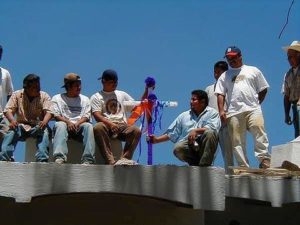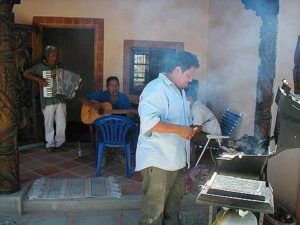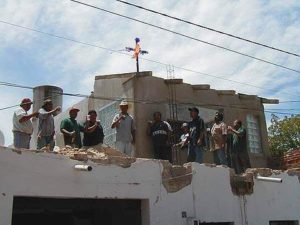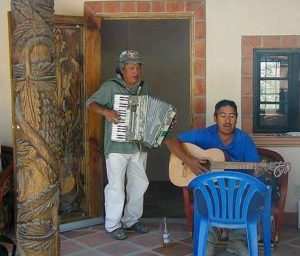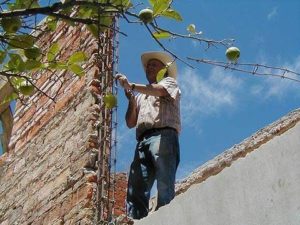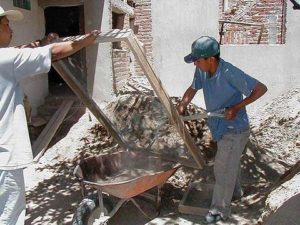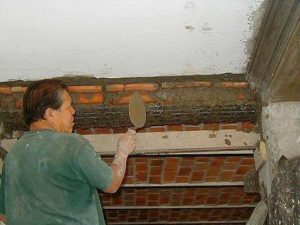Each year on May 3rd processions of singing pilgrims carrying streamers and flowers wend their way through towns, cities and villages of Mexico to decorate the crosses along roadsides and on mountaintops to honor and remember the Holy Cross. All over the country thousands of crosses in streets, parks, cemeteries and churchyards are visited and decorated each year to honor the cross on which Jesus was crucified.
The people with their colorful garlands of real and crepe paper flowers and ribbons bring to mind flower-filled May Baskets, erecting and decorating of a Maypole with the dancers’ multicolored streamers, the crowning of the Queen of the May with wreaths of flowers. and the many other colorful traditions of May Day celebrations. All of these traditions are remnants of Roman and Druid agricultural and fertility rites celebrating the beginning of summer in countries and cultures around the world.
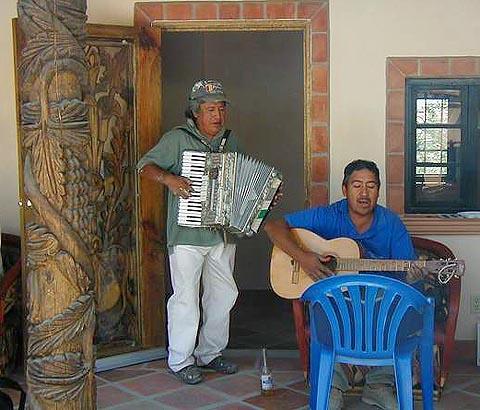
POPE JOHN XXIII CANCELS THE CELEBRATION
Celebrations for The Day of the Discovery of the Holy Cross La Santa Cruz on May 3rd ceased in all other countries of the world when Pope John XXIII removed the feast day from the Catholic liturgical calendars in 1960. The Pope was planning to focus attention on the celebration of the Exaltation of the Holy Cross on September 14.
ONLY IN MEXICO. . .
Most of the rest of the world, heard and obeyed the wishes of the Pope. But in Mexico, the construction workers union had long been celebrating the Day of the Holy Cross as their special feast day. Because the church understands the ability of the people of Mexico to keep traditions they prefer, even when the church doesn’t approve, the Mexican episcopate made applications to Rome to keep May 3rd . The faith and desire of the construction unions won, Rome wisely agreed to allow the popular spring celebration also called the Day of the Flowery Cross to continue, just in Mexico and thus avoiding a difficult and unpopular fight.
THE CONSTRUCTION INDUSTRY
As the Mexican economy has recovered following the peso crisis of 1994, the construction industry has flourished in Mexico, and with it the celebration of the feast day of the construction workers.
In Mexico City, the Primate Archbishop conducts services at the Cathedral, blessing the colorfully decorated crosses carried in procession by the bricklayers and masons. This special mass asks for the protection of the workers on the job, gives thanks for their safety and success during previous year, and asks for continued good projects, conditions and salaries in the coming year.
Due to the immense amount of construction at Lake Chapala and the huge number of men working in the trade the holiday in the lakeside villages is celebrated much more dramatically than in less developed areas.
COHETES – A MACHO RIVALRY
The first dramatic volley of thousands of joyful cohetes (sky rockets) begins at midnight as each crew attempts to be the first to announce the celebration of the Day of the Holy Cross. This macho rivalry between workers continues sporadically all night and for the entire 24 hours of May 3 with each crew hoping to set off more sky rockets than their competitors to remind one and all that this is a special day.
PROCESSIONS, MASS, AND CANELA WITH ROMPOPE
As dawn breaks, the volleys of cohetes increase, to wake the men, and call them to the early morning mass said in their honor. To ward off any chill of the early May morning, an abundant supply of rompope, a milk based liquor and brandy is carried in the processions to and from mass, along with huge pots of hot cinnamon canela tea and giant sleeves of cups. With the comparable affluence that sufficient work has brought to Lakeside, not all in the procession walk to and from the church. Many of the work crews ride in the back of pickup trucks, with the kettles and bottles and cups. A town band or two is included in the procession, to lead “Las Mananitas” the song that begins every fiesta day in Mexico, and then to provide enough ranchero and banda music to let the community know that a special celebration in the church year, and a special time in the lives of the workers is in process.
ERECTING THE CROSS
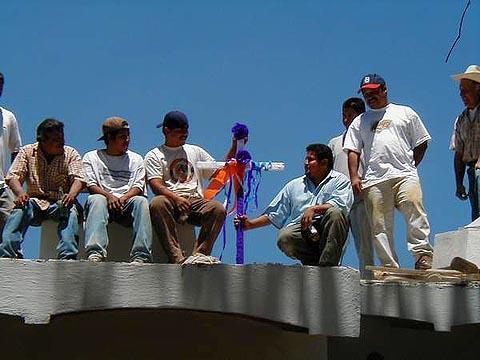
At every job site in the area, the rest of the day will be filled with a great deal of noise, cohetes, music, laughter, activity, food, and drink as the men return after mass to work, and to celebrate. Most crews fasten a cross brightly decorated with crepe paper flowers and streamers onto the uppermost section of the building, continuing the tradition that began with the building of churches by the Spanish in the 1500’s. During the celebration on the day when the cross was added to the top of the newly finished church, the workers were honored with food and drink and allowed a rare opportunity to enjoy traditional dancing. The workers offered burning copal, the local pungent incense, music and fireworks to frighten any loitering evil spirits from the area. In the 21st Century, puffs of smoke dot the sky marking the construction sites and the crews of joyful and thankful workers, still releasing sky rockets, though they no longer remember originally they were to clear the area of dangerous spirits.
THE FIESTA BEGINS
Work ends at noon, when the patron, the owner of the project begins the next phase of the festival with tequila toasts, known as copitas. He toasts the success of the project and the health and happiness of the crew. The owner also sponsors a comida (midday meal). This reflects the pre-Columbian custom of placing food and drink on specially constructed altars to dedicate new buildings, and to please the gods.
The patron and the contractor arrange for music, and for hundreds of deafening skyrockets and drinks for the remainder of the day and evening. Although few remember why celebrations follow a set pattern, most of the customs during celebrations in Mexico reflect the time when the Spanish priests abolished the bloody sacrifices. The people, fearing the anger of the Gods, and the ensuing destruction of their homes and lives, quietly incorporated as many of the old traditions as they thought necessary to appease the gods.
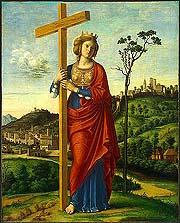 Few in Mexico remember the other very important historical link between bricklayers, masons and the Holy Cross and a Saint. Legend tells us that nearly 1700 years ago Helen, the mother of Emperor Constantine is credited with finding on May 3rd, 332 A.D. the actual cross on which Jesus was crucified.
Few in Mexico remember the other very important historical link between bricklayers, masons and the Holy Cross and a Saint. Legend tells us that nearly 1700 years ago Helen, the mother of Emperor Constantine is credited with finding on May 3rd, 332 A.D. the actual cross on which Jesus was crucified.
How this woman’s life evolved from serving wench to mother of the Roman Emperor, including her conversion to Christianity when being a Christian carried a death sentence, the finding of the True Cross under three centuries of debris, her association with the construction workers who were assisting her in building a church at Calvary is the fascinating story of Santa Elena, which can be found in Mexico Connect at SANTA ELENA, DISCOVERER OF THE HOLY CROSS

